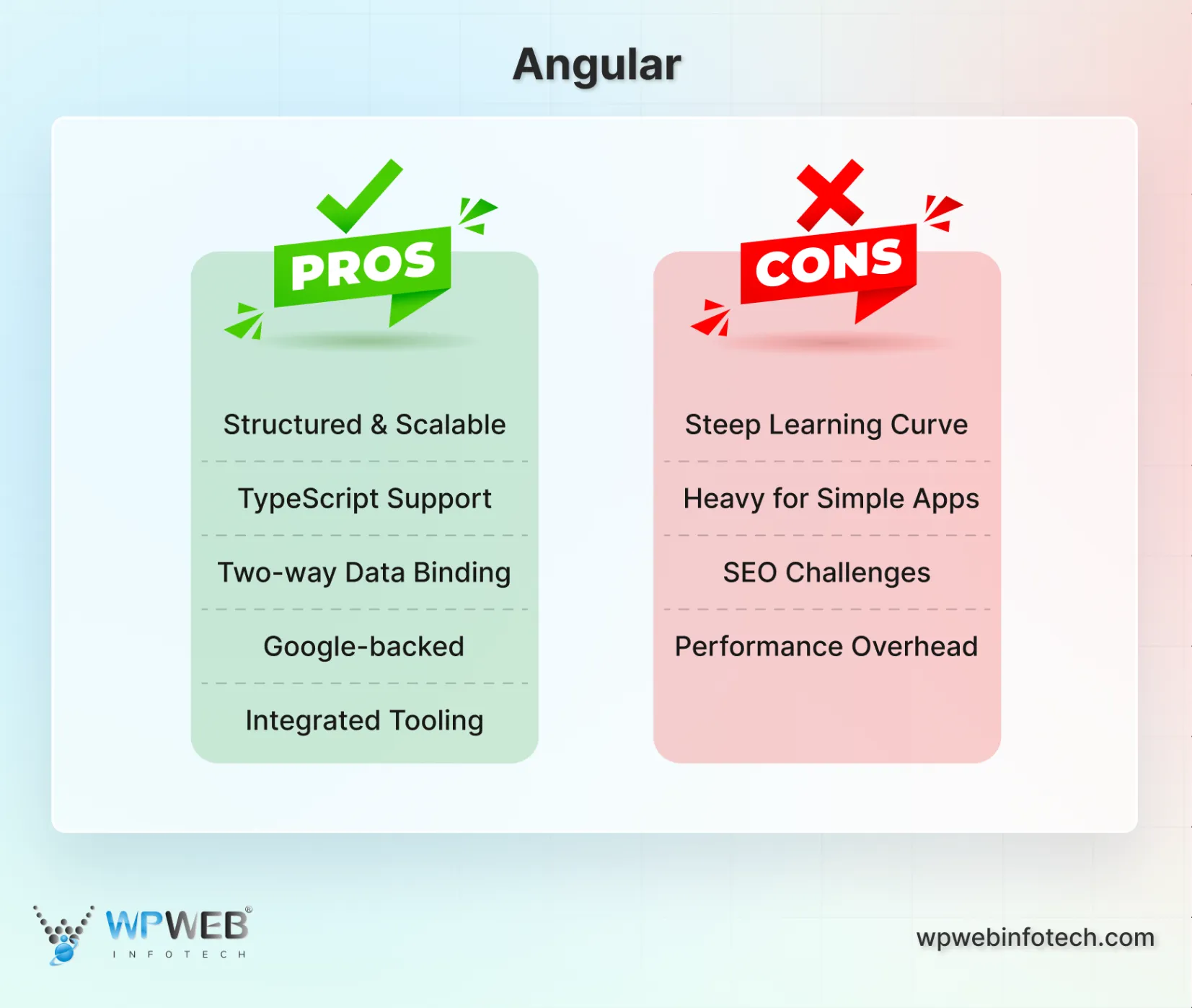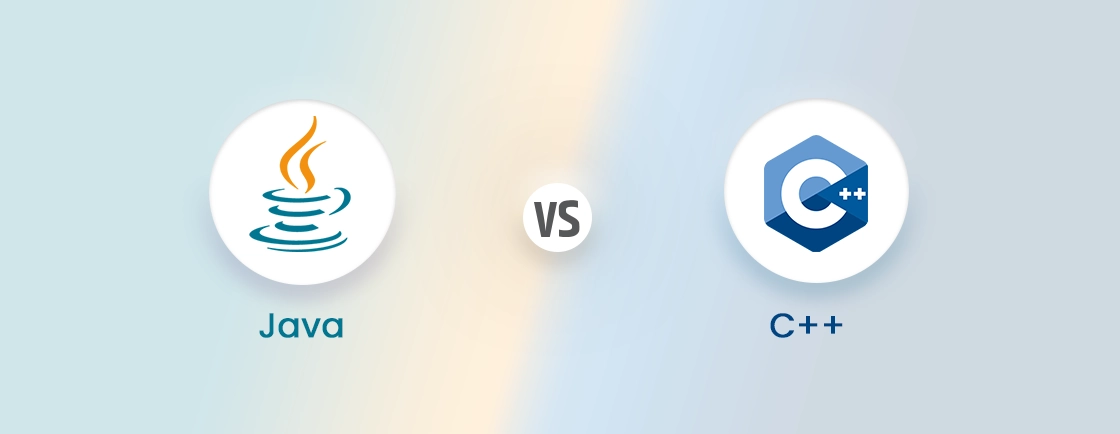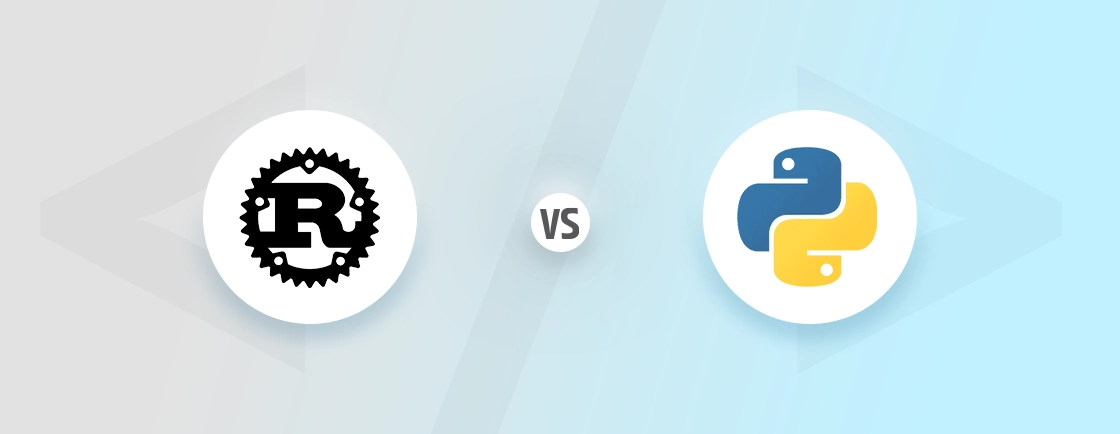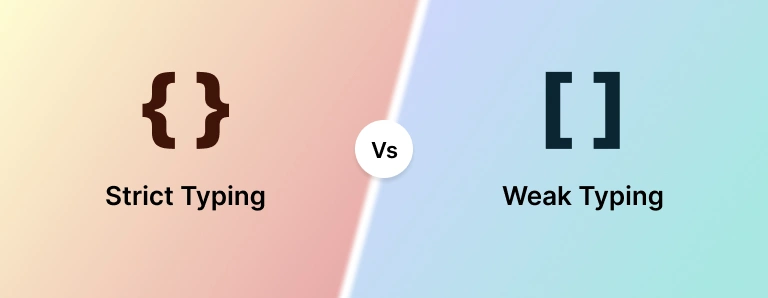Table of Contents
When it comes to a complete full-stack web development, you need to take care of both the front-end and back-end. To that end, two of the most popular frameworks available are Angular and Laravel.
Angular, one of the top front-end JavaScript frameworks, excels at building dynamic single-page applications. Laravel is a PHP back-end framework that streamlines server-side development with elegant syntax and robust features. Both are powerful, but their strengths lie in different domains. So we can’t compare them straight away.
This blog compares Angular vs Laravel based on a few core differences, showcasing how the web development experts choose between them. Let’s begin.
Angular vs Laravel: Comparison Table
| Factor | Angular | Laravel |
|---|---|---|
| Type | Front-end framework | Back-end framework (MVC) |
| Language | TypeScript/JavaScript | PHP |
| Architecture | Component-based | MVC (Model-View-Controller) |
| Performance | Fast client-side rendering | Optimized server-side processing |
| Learning Curve | Steeper (RxJS, decorators) | Moderate (Eloquent, Blade) |
| Scalability | High for complex UIs | High for backend services |
| Database Support | Works via APIs (Firebase, REST) | Built-in ORM (Eloquent), MySQL, PostgreSQL |
Choose Angular if you need a dynamic, interactive front end. Or pick Laravel if you require a robust, scalable backend.
Overview of Angular
Angular is a front-end JavaScript framework developed and maintained by Google, designed for building scalable, dynamic single-page applications (SPAs). Unlike basic JavaScript libraries, Angular provides a structured, component-based architecture. That makes it ideal for complex enterprise-grade applications.
Key Features of Angular
- TypeScript-based: Enhances code quality with static typing and OOP features.
- Component-based UI: Encapsulates reusable UI elements with HTML templates and TypeScript logic.
- Two-way Data Binding: Synchronizes data between model and view in real time.
- Dependency Injection: Improves modularity and testability.
- RxJS for Reactive Programming: Handles asynchronous operations efficiently.
- CLI Tooling: Streamlines project setup, testing, and deployment.
Pros and Cons of Angular

Pros of Angular
- Structured & Scalable: Component-based architecture enforces clean code, ideal for large applications.
- TypeScript Support: Static typing reduces runtime errors and improves maintainability.
- Two-way Data Binding: Automatic UI updates streamline dynamic content rendering.
- Google-backed: Strong community, long-term support, and regular updates.
- Integrated Tooling: CLI simplifies testing, building, and deployment.
Cons of Angular
- Steep Learning Curve: Requires understanding RxJS, decorators, and dependency injection.
- Heavy for Simple Apps: Overkill for small projects due to its full-fledged nature.
- SEO Challenges: SPAs require extra effort (SSR via Angular Universal) for search visibility.
- Performance Overhead: Large bundle size can slow down initial load times.
Angular has a steeper learning curve compared to React or Vue. But, its full-fledged framework approach means you aren’t reliant on third-party libraries. So it’s a good choice for large-scale front-end development. Our Angular developers for hire could be of help with that.
Overview of Laravel
Laravel is a modern PHP framework designed for elegant, efficient back-end development. This framework is known for its expressive syntax and developer-friendly tools. It simplifies complex tasks like authentication, routing, and database management. That makes it a top choice for web applications, APIs, and enterprise systems.
Key Features of Laravel
- Eloquent ORM: A powerful ActiveRecord implementation for seamless database interactions.
- Blade Templating Engine: Lightweight yet flexible, with inheritance and reusable components.
- Artisan CLI: Automates repetitive tasks (migrations, testing, scaffolding).
- Built-in Authentication & Security: Includes CSRF protection, encryption, and secure password hashing.
- Laravel Sanctum / Passport: Simplifies API token and OAuth2 authentication.
- Queue & Task Scheduling: Handles background jobs efficiently (e.g., emails, reports).
Pros and Cons of Larvel

Pros of Laravel
- Developer-friendly: Elegant syntax, extensive documentation, and built-in features (auth, queues).
- Eloquent ORM: Simplifies database operations with an intuitive ActiveRecord implementation.
- Blade Templating: Lightweight yet powerful for server-rendered views.
- Robust Ecosystem: Tools like Laravel Forge, Nova, and Horizon streamline deployment and admin tasks.
- API & Microservices Ready: Built-in support for RESTful APIs and stateless authentication.
Cons of Laravel
- PHP Limitations: Slower than Node.js/Go for high-traffic real-time apps (though optimizations help).
- Less Performant at Scale: Requires caching (Redis) and tuning for heavy loads.
- Monolithic Default Structure: Not as modular as micro-frameworks like Lumen.
- Fewer Real-time Features: Needs external libraries (Laravel Echo) for WebSockets.
Laravel’s development approach reduces boilerplate code, so teams can focus on business logic rather than infrastructure. While PHP-based, its performance rivals modern stacks when optimized (OPcache, Laravel Octane).
For the best results with this framework, hire Laravel developers.
Detailed Differences Between Angular & Laravel
While both Angular and Laravel are powerful web development tools, they serve fundamentally different purposes. So let’s compare them based on some key factors.
Ease of Use
Angular has a steep learning curve due to its reliance on TypeScript, RxJS, and a structured component-based architecture. While powerful, beginners may struggle with concepts like dependency injection and reactive programming.
Laravel, on the other hand, is designed for developer convenience. Its expressive syntax, built-in tools (Artisan, Eloquent), and comprehensive documentation make it easier to learn and use, even for PHP newcomers.
Verdict
Laravel wins for ease of use, especially for rapid development.
Performance
Angular excels in client-side rendering with optimized change detection and ahead-of-time (AOT) compilation. However, SPAs can suffer initial load delays due to large bundle sizes unless lazy loading is implemented.
Laravel, however, performs efficiently for server-side logic but can lag under heavy traffic without caching (Redis) or PHP optimizations (OPcache). Real-time features require extra setup (Laravel Echo, WebSockets).
Verdict
Angular is faster for dynamic UIs; Laravel needs tuning for high-load backends.
Scalability
Angular scales well for large front-end applications thanks to modular components and lazy loading. However, complex state management (NgRx) can become cumbersome.
Laravel supports horizontal scaling with database sharding, queues, and microservices via Lumen. Its monolithic default structure may require refactoring for extreme scalability.
Verdict
Both scale well, but Laravel’s back-end flexibility gives it a slight edge.
Security
Angular provides built-in safeguards against XSS and CSRF, but SPAs rely heavily on secure API practices (JWT validation, CORS policies).
Laravel offers robust security out-of-the-box: encrypted sessions, CSRF protection, SQL injection prevention via Eloquent, and secure authentication (Sanctum/Passport).
Verdict
Laravel wins with more built-in security features.
Third-party Integrations
Angular integrates seamlessly with Firebase, state management (NgRx), and UI libraries (Angular Material). However, dependency on external APIs can complicate setups.
Laravel supports diverse integrations (payment gateways, AWS, Redis) via Composer. Its RESTful API compatibility simplifies front-end framework pairings.
Verdict
Laravel’s PHP ecosystem offers broader integration options.
Support
Angular, backed by Google, has strong enterprise adoption and regular updates. Community support is vast but leans toward advanced users.
Laravel boasts a massive community, detailed documentation, and premium tools (Forge, Envoyer). PHP’s ubiquity ensures abundant resources.
Verdict
Tie—both have excellent support, but Laravel’s beginner-friendly resources stand out.
Final Verdict
When it comes to front-end SPAs, Angular is the clear choice for structured, scalable UIs. But on the other hand, Laravel is superior for rapid, secure, and maintainable server-side apps.
Our professional web development company can also ensure a balanced, high-performance solution. That is, by combining both Angular (for APIs) and Laravel (for the front-end).
When to Choose Angular vs Laravel?
Both Angular and Laravel are excellent web development frameworks with different strengths and weaknesses. So they are both suitable for different use cases.
Choose Angular If You Need:
- A Dynamic Single-page Application (SPA): Angular excels at building interactive, real-time UIs like dashboards, admin panels, etc. (e.g., Gmail, Microsoft Office 365).
- Structured Front-end Architecture: Its component-based design enforces clean code, making it ideal for large teams and long-term projects.
- TypeScript Advantages: Strong typing reduces bugs and improves maintainability for complex applications.
- Google Ecosystem Integration: If you rely on Firebase, Google Cloud, or Material Design, Angular offers seamless compatibility.
Choose Laravel If You Need:
- Robust Back-end for Web Apps or APIs: Laravel simplifies server-side logic, authentication, and database management (e.g., eCommerce backends, SaaS).
- Rapid Development: Features like Eloquent ORM, Blade templating, and Artisan CLI accelerate prototyping and deployment.
- Scalable APIs: Built-in support for RESTful APIs and authentication (Sanctum/Passport) makes it perfect for mobile/front-end integrations.
- PHP Ecosystem Benefits: If your team knows PHP or you rely on WordPress, Symfony, or legacy systems, Laravel fits naturally.
And if you are still unsure about which platform works for you, consult with the professionals.
So, Which is Better? Angular or Laravel?
The truth is, Angular and Laravel aren’t direct competitors—they solve different problems. Choose Angular if you need a structured, powerful front-end framework for dynamic, enterprise-grade applications. Choose Laravel as a flexible, elegant back-end framework to develop robust APIs or server-rendered web apps quickly.
For full-stack projects? Combine them. But the better “better” framework depends entirely on your project’s needs. Need a slick UI? Angular. Need a reliable backend? Laravel. Need both? Use both.
If you want help with ensuring the best results with these platforms, connect with our web development professionals today!
FAQs on Angular vs Laravel
Can Angular and Laravel be used together?
Yes! A common architecture uses Laravel as a back-end API with Angular as the front-end. This combination is powerful for full-stack applications like enterprise dashboards or SaaS platforms.
Is Laravel slower than Angular?
Not directly comparable—they serve different purposes. Angular runs in the browser, offering fast client-side rendering after the initial load. Laravel handles server-side processing; speed depends on PHP optimizations (OPcache, queues) and database efficiency.
Can Laravel replace Angular?
No—they’re complimentary. Laravel is a back-end framework, while Angular is a front-end framework. However, Laravel can use Blade templates for server-rendered views instead of an SPA like Angular.
Which is more secure: Angular or Laravel?
Laravel provides built-in security (CSRF protection, SQL injection prevention, encryption). Angular also has safeguards (XSS protection) but relies on secure API practices (HTTPS, JWT validation).
Compare the best tech side by side.
Our in-depth comparisons help you see features, pros & cons, and choose the right tools confidently.





